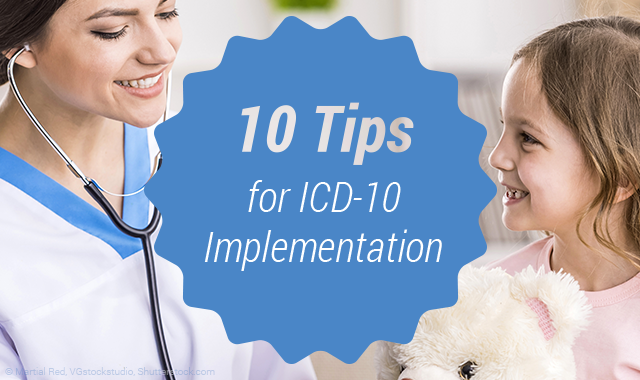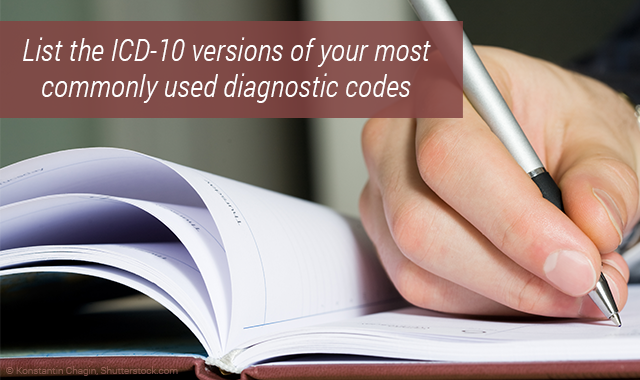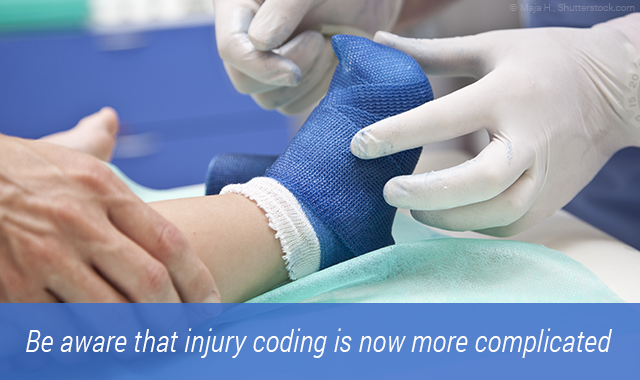Top 10 tips for ICD-10 adoption
Contemporary Pediatrics brings you 10 tips to make the switch to the ICD-10 coding system.


Barring a last minute reprieve, International Classification of Diseases version 10 (ICD-10) diagnostic coding went into effect the first of this month. If you're one of the many who hasn't implemented the new coding system, here are 10 tips to help make the transition as painless as possible.
The Ultimate ICD-10 Checklist.



Don't panic
One of my favorite books is the “Hitchhikers Guide to the Galaxy” authored by Douglas Adams (he also wrote many early Doctor Who episodes). On the cover of the electronic guide book featured in the story is written “Don’t Panic,” an expression which applies very well to ICD-10 adoption. After all, it’s not like it’s the end of the world. It will undoubtedly take time for you and your staff to get used to ICD-10. Just like all the many healthcare reforms we have experienced before, be assured that survival is imminent. However, conversion will require many changes in your well established habits! So stop complaining and get to work!



Get a line of credit
Many experts anticipate that ICD-10 may have a negative impact on cash flow, as it may extend the processing of claims by weeks or even months. As noted in my March article, the cost of implementing ICD-10 will cost small medical practices anywhere from $56,639 to $226,105 and many times this number for larger practices.1 It is estimated by some that the switch from ICD-9 to ICD-10 will negatively impact office productivity by at least 6%.2 According to the American Association of Professional Coders (AAPC), when the ICD-10 system was implemented in Canada in 2000, the average coding time per claim increased from 15 minutes to 33 minutes and turnaround time went from 69 days to 139 days.3
If you don’t have sufficient cash reserve to survive a substantial reduction in cash flow, it would be wise to go to a lender and establish a line of credit. Get a line of credit that is equal to 3 months of salaries and accounts payable. If your reserves are less than this, you might be at risk for a reduction in physician paychecks.
References
1. “The Cost of Implementing ICD-10 for Physician Practices – Updating the 2008 Nachimson Advisors Study,” Nachimson Advisors, LLC, February 12, 2014, http://www.athenahealth.com/knowledge-hub/ICD-10/medical-procedure-codes.php#sthash.BeFnJyep.dpuf
2. Weems, Shelley, Pamela Heller, and Susan Fenton. “Results from the Veterans Health Administration ICD-10-CM/PCS Coding Pilot Study.” Paper presented at the ICD-10/CAC Summit, Baltimore, MD, April 2014. â¨
3. American Association of Professional Coders (AAPC) (http://www.aapc.com/icd-10/icd-10-white-paper.aspx)



Take a course
Unfortunately, ICD-10 is fairly complicated, so it would be wise for you and your staff to participate in an online ICD-10 training course and make use of the many online tools to help with adoption of the new coding system.
Web sites: ICD-10 online training courses
- American Health Information Management Association course: https://secure-content.optimizehit.com/ahima/
Note: $250 fee
- American Academy of Professional Coders course: https://www.aapc.com/icd-10/icd-10-physician-documentation.aspx
Note: $395 fee
- World Health Organization: http://apps.who.int/classifications/apps/icd/icd10training
Note: Free self-learning tool
Also be aware that the Centers for Medicare and Medicaid Services (CMS) have a variety of online resources available as well.



Make sure your office coders are up to speed
If you use a billing service, confirm that they have prepared for the conversion. However, if you utilize in house coders and bill insurance companies yourself, make sure that your coders have been “re-certified” to be able to bill according to ICD-10. Your coders can take a self-paced, 16-hour online course for $400 to retain their AAPC certification. Speaking of deadlines: AAPC certified coders must complete certification by December 31, 2015 to retain their certification!!



Make a list the ICD-10 versions of your most commonly used diagnostic codes
Although ICD-10 has 69,000 codes, over 55,000 codes more than ICD-9, most pediatricians utilize a limited number of ICD-9 codes. Many convert easily to ICD-10 format. For example, what used to be “unspecified conjunctivitis”-372.30 in ICD-9 lingo-is coded H10.9 in ICD-10. Keep in mind that ICD-10 adds new elements, such as site laterality, to many codes. There are dozens of codes for otitis, so find the few that you can adopt and use most easily. In documenting an encounter for otitis media, providers should document type of infection (serous, suppurative, allergic, etc), infectious agent if known, chronicity (acute, recurrent, chronic), left or right side or bilateral, and if there is a rupture of the tympanic membrane. Also, document if there any contributing factors, such as tobacco smoke.



Be aware that injury coding is now more complicated
Documentation of injuries will need to describe the injury, including laterality, and whether the visit is initial encounter or subsequent encounter. In addition, you must identify the cause of the injury (ie, struck by car), where it occurred (near the patient’s school) and what activity the patient was doing (ie, crossing the street). In cases of concussion, we need to include whether there was loss of consciousness and the duration of the loss of consciousness. We need to indicate if a condition is acute or chronic and any external factors that were related to the condition.



Be aware that well visit codes are different
Codes for newborn health examinations are reported with code Z00.110 for a newborn under 8 days old or code Z00.111 for a newborn 8 to 28 days old. For children 29 days old and older, use 1 of 2 codes: Z00.121, encounter for routine child health examination with abnormal findings, or Z00.129 without abnormal findings. When a child reaches 15 years of age, you can use code Z00.00 for exams without abnormal findings, and Z00.01 if there are abnormal findings. Also-good news-under ICD-10, if you immunize at a visit, you use 1 code, Z23, regardless of which vaccines were administered or the number of vaccine administered.



Talk to your EHR vendor
You are pretty much at the mercy of your electronic health record (EHR) vendor when you update your software to the latest ICD-10-compliant version. Some vendors will charge you a fee, while others will not. Use words like “please” and “thank you,” if you are pleasantly surprised regarding the upgrade details. If you are displeased, you can tell your vendor you are considering switching EHRs. If the vendor offers training regarding the transition, make sure you and your staff participate.



Document more appropriately
As mentioned, many codes require more extensive documentation under ICD-10 compared to what we provided under ICD-9. If your documentation lacks critical data, you may risk denial of the claim. When indicated, remember to include documentation of laterality, whether you’re are seeing a patient for an initial visit for an injury, a subsequent encounter, or a sequelae of the episode, in addition to the nature of the injury.


Monitor denials and cash flow
Don’t assume that your billing software or your insurance company will prepare or process claims to your satisfaction. Be pleasantly surprised if no claims are denied, but “Don’t panic” if many are; just slowly work through the issues. Remember, ICD-10 is not the end of the world, but it just feels like it is. And, by the way, the World Health Organization is now in the process of preparing ICD-11, which is due to be released in 2017!
Anger hurts your team’s performance and health, and yours too
October 25th 2024Anger in health care affects both patients and professionals with rising violence and negative health outcomes, but understanding its triggers and applying de-escalation techniques can help manage this pervasive issue.